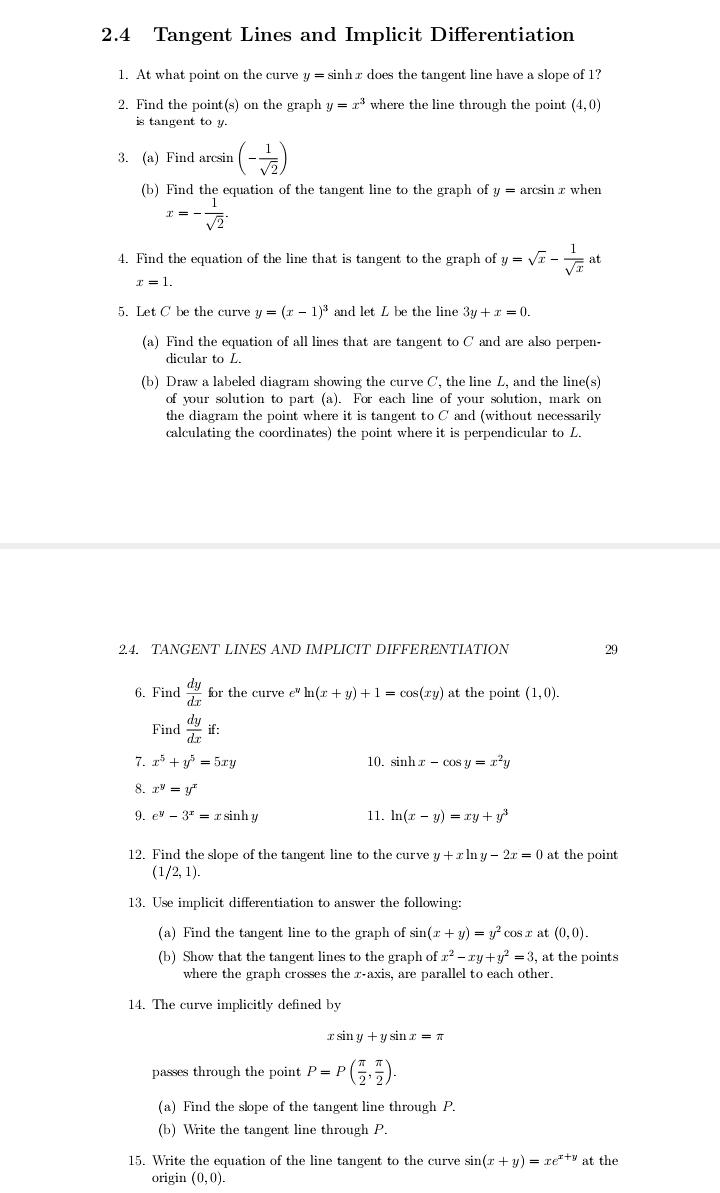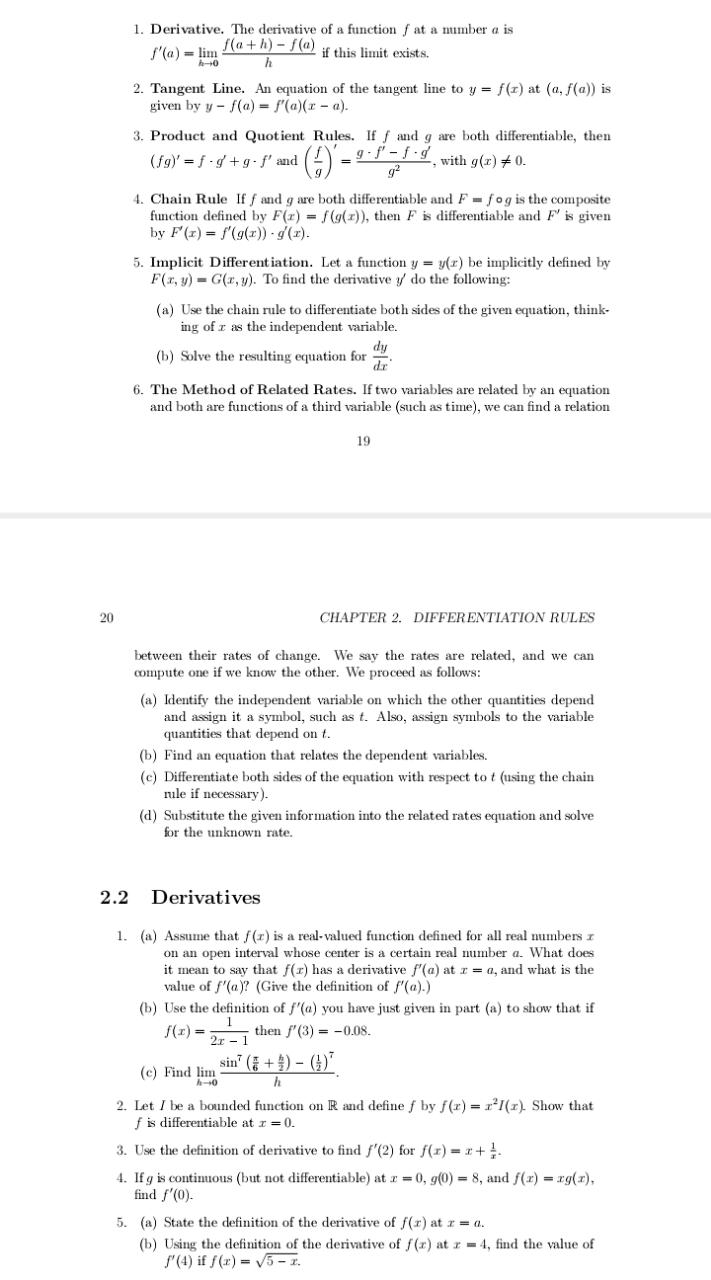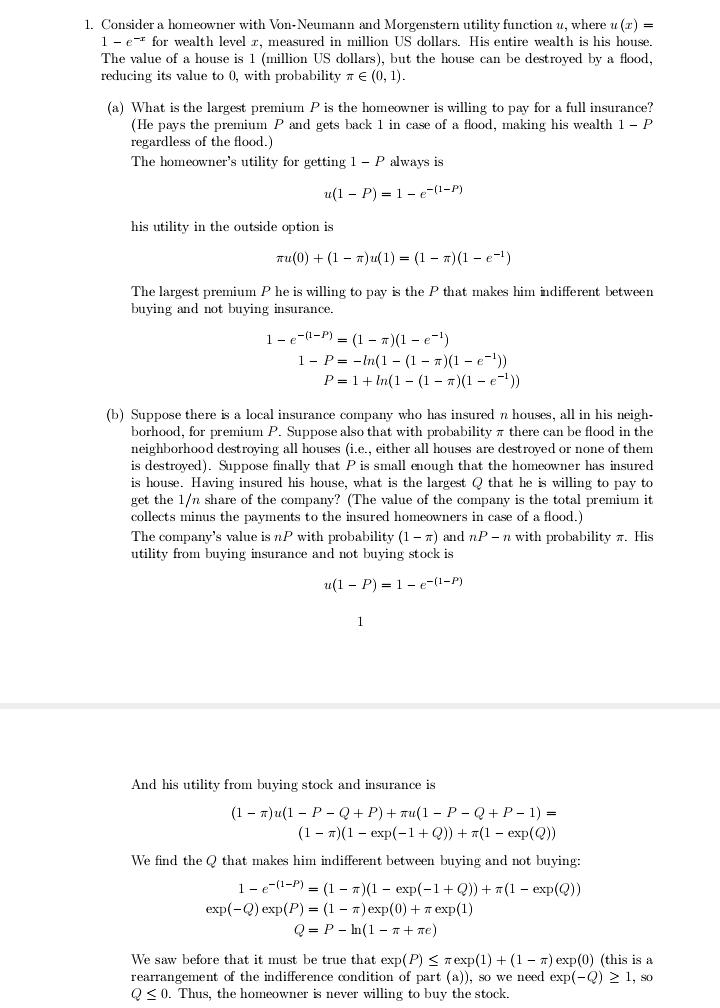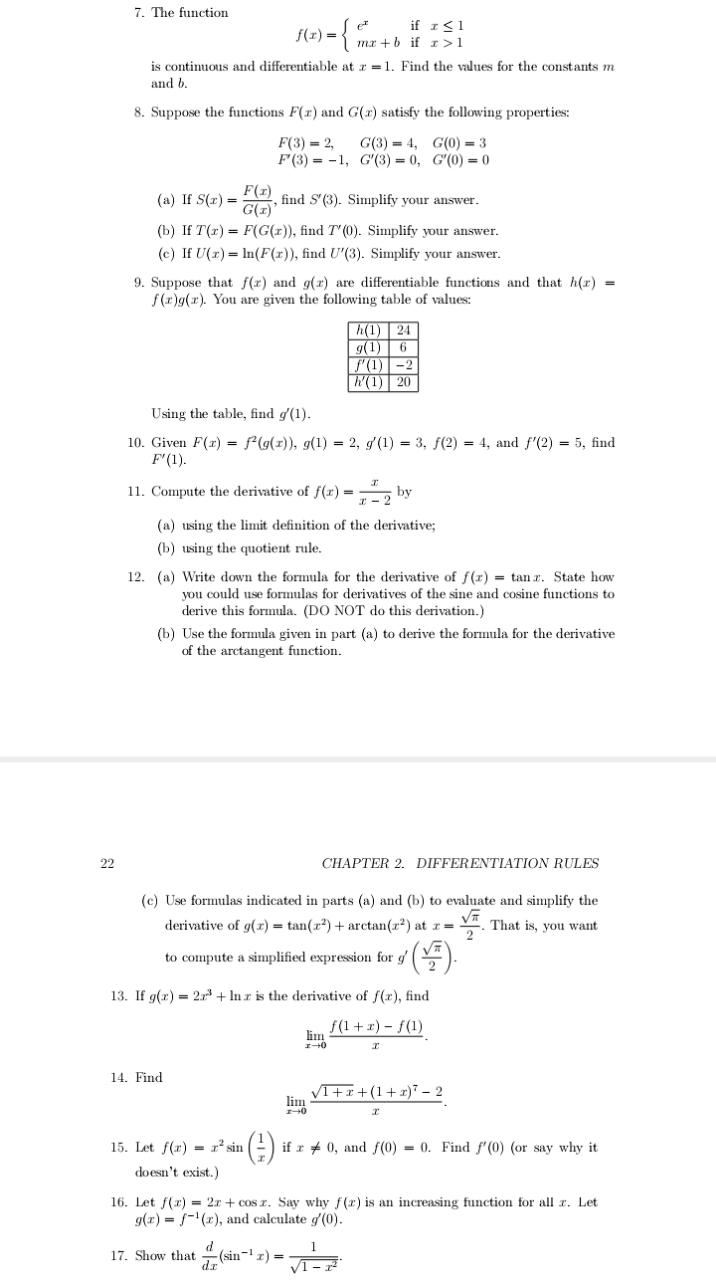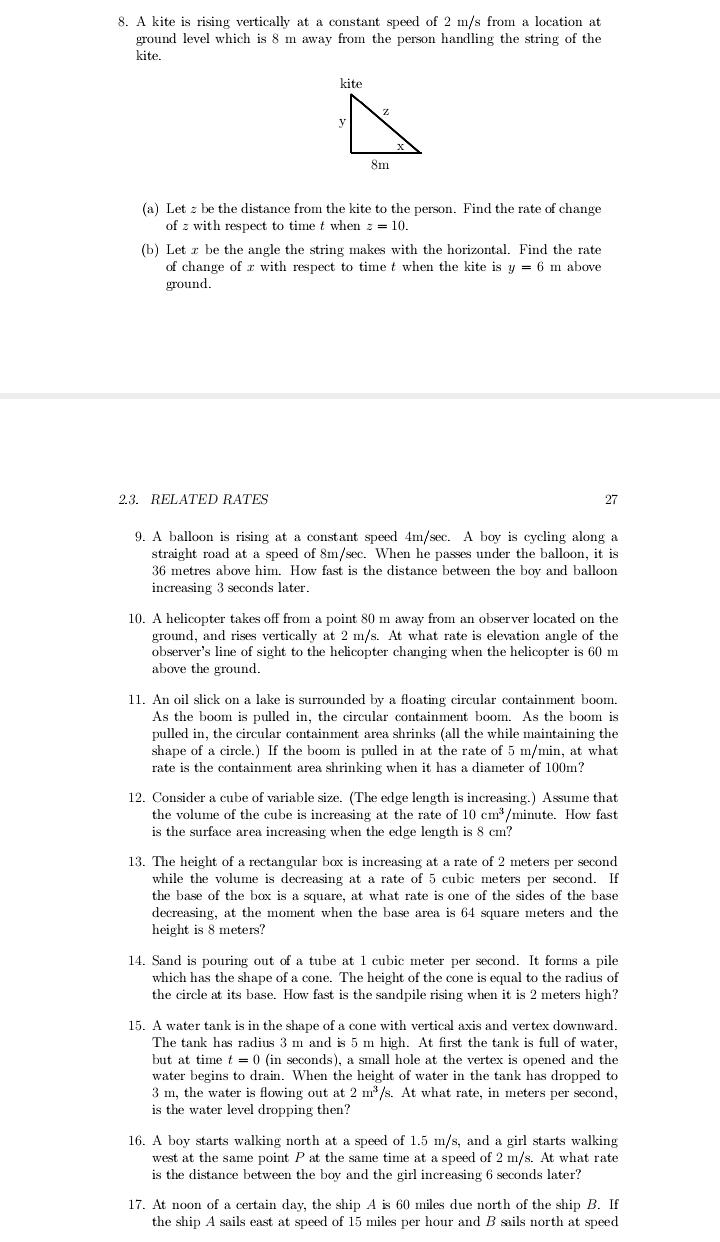




$$explain clearly...
2.4 Tangent Lines and Implicit Differentiation 1. At what point on the curve y = sinh r does the tangent line have a slope of 1? 2. Find the point(s) on the graph y = a where the line through the point (4, 0) is tangent to y. 3. (a) Find arcsin(- (b) Find the equation of the tangent line to the graph of y = arcsin r when 1 V2 4. Find the equation of the line that is tangent to the graph of y = Vi - at VI 1=1. 5. Let C be the curve y = (r - 1)* and let [ be the line 3y + r = 0. (a) Find the equation of all lines that are tangent to C and are also perpen- dicular to L. (b) Draw a labeled diagram showing the curve C, the line L, and the line(s) of your solution to part (a). For each line of your solution, mark on the diagram the point where it is tangent to C and (without necessarily calculating the coordinates) the point where it is perpendicular to L. 2.4. TANGENT LINES AND IMPLICIT DIFFERENTIATION 29 6. Find " for the curve e" In(r + y) + 1 = cos(ry) at the point (1, 0). Find - dy if: dx 7. p' ty' = bry 10. sinh r - cosy = ry 8. 1 = y 9. ey - 3" = rsinh y 11. In(x - y) = ry+y' 12. Find the slope of the tangent line to the curvey +clay - 2r = 0 at the point (1/2, 1). 13. Use implicit differentiation to answer the following: (a) Find the tangent line to the graph of sin( + y) = y' cosr at (0, 0). (b) Show that the tangent lines to the graph of r' - ry ty' =3, at the points where the graph crosses the r-axis, are parallel to each other. 14. The curve implicitly defined by rainy + y sin x = * passes through the point P = P (2. 2). (a) Find the slope of the tangent line through P. (b) Write the tangent line through P. 15. Write the equation of the line tangent to the curve sin(r + y) = refty at the origin (0, 0).1. Derivative. The derivative of a function f at a number a is f'(a) = lim !(a +h) - @ if this limit exists. 2. Tangent Line. An equation of the tangent line to y = f(r) at (a, f(a)) is given by y - f(a) = f(a)(x - a). 3. Product and Quotient Rules. If f and g are both differentiable, then (fg)' = f - g + g. f' and (!) g . f - f g, with g(x) # 0. g2 4. Chain Rule If f and g are both differentiable and F = fog is the composite function defined by F(r) = /(g(x)), then F is differentiable and F' is given by F(x) = f'(g(1)) - 9(2). 5. Implicit Differentiation. Let a function y = y(r) be implicitly defined by F(r, y) - G(x, y). To find the derivative y do the following: (a) Use the chain rule to differentiate both sides of the given equation, think- ing of r as the independent variable. (b) Solve the resulting equation for de 6. The Method of Related Rates. If two variables are related by an equation and both are functions of a third variable (such as time), we can find a relation 19 20 CHAPTER 2. DIFFERENTIATION RULES between their rates of change. We say the rates are related, and we can compute one if we know the other. We proceed as follows: (a) Identify the independent variable on which the other quantities depend and assign it a symbol, such as t. Also, assign symbols to the variable quantities that depend on t. (b) Find an equation that relates the dependent variables. (c) Differentiate both sides of the equation with respect to t (using the chain rule if necessary)- (d) Substitute the given information into the related rates equation and solve for the unknown rate. 2.2 Derivatives 1. (a) Assume that f (r) is a real- valued function defined for all real numbers r on an open interval whose center is a certain real number a. What does it mean to say that f(x) has a derivative f'(a) at z = o, and what is the value of f'(a )? (Give the definition of f'(a).) (b) Use the definition of f'(a) you have just given in part (a) to show that if f(x) = 2 -1 then f'(3) = -0.08. (c) Find him sin' (8 + !) - () 2. Let / be a bounded function on R and define f by f(x) = x'/(x) Show that f is differentiable at r = 0. 3. Use the definition of derivative to find f'(2) for f(x) = >+ 4. 4. If g is continuous (but not differentiable) at z = 0, g(0) = 8, and f(x) = ag(x), find f'(0). 5. (a) State the definition of the derivative of f(r) at r = a. (b) Using the definition of the derivative of f(r) at z = 4, find the value of S'(4) if / (x) = v5 -1.1. Consider a homeowner with Von-Neumann and Morgenstern utility function u, where u (7) = 1 - e" for wealth level z, measured in million US dollars. His entire wealth is his house. The value of a house is 1 (million US dollars), but the house can be destroyed by a flood, reducing its value to 0, with probability # E (0, 1). (a) What is the largest premium P is the homeowner is willing to pay for a full insurance? (He pays the premium P and gets back 1 in case of a flood, making his wealth 1 - P regardless of the flood.) The homeowner's utility for getting 1 - P always is u(1 - P) = 1 - e-(1-p) his utility in the outside option is Tu(0) + (1 - #)u(1) = (1 - *) (1 -e-1) The largest premium P he is willing to pay is the P that makes him indifferent between buying and not buying insurance. 1 - e-(-P) = (1 - m)(1 -e-]) 1 - P= -In(1 - (1 - #)(1 - e-1)) P=lth(1 - (1 - w)(1 - e-')) (b) Suppose there is a local insurance company who has insured n houses, all in his neigh- borhood, for premium P. Suppose also that with probability a there can be flood in the neighborhood destroying all houses (i.e., either all houses are destroyed or none of them is destroyed). Suppose finally that P is small enough that the homeowner has insured is house. Having insured his house, what is the largest @ that he is willing to pay to get the 1 share of the company? (The value of the company is the total premium it collects minus the payments to the insured homeowners in case of a flood.) The company's value is n with probability (1 - #) and nP - n with probability n. His utility from buying insurance and not buying stock is u(1 - P) = 1 - e-(1-P) And his utility from buying stock and insurance is ( 1 - m)u( 1 - P - Q + P) + mul( 1 - P - Q + P - 1) = (1 - m)(1 - exp(-1 + ()) + #(1 - exp(Q)) We find the Q that makes him indifferent between buying and not buying: 1 - e-(1-P) = (1 - w)(1 - exp(-1 + Q)) + m(1 - exp(@)) exp(-Q) exp(P) = (1 - #)exp(0) + # exp(1) Q = P - In(1 - * + me) We saw before that it must be true that exp( P) 1 is continuous and differentiable at r = 1. Find the values for the constants m and b. 8. Suppose the functions F(r) and G(r) satisfy the following properties: F(3) = 2, G(3) = 4, G(0) = 3 F(3) = -1, G'(3) = 0, G'(0) = 0 (a) If s(x) =7 F(I) G(I) , find S'(3). Simplify your answer. (b) If T(r) = F(G(x)), find T'(0). Simplify your answer. (e) If U(x) = In(F(r)), find U'(3). Simplify your answer. 9. Suppose that f(x) and g(r) are differentiable functions and that h(r) = f(x)g(r). You are given the following table of values: h(1) 24 9(1) 6 F(1) -2 h'(1) 20 Using the table, find g'(1). 10. Given F(x) = f(g(x)), g(1) = 2, g'(1) = 3, f(2) = 4, and f'(2) = 5, find F'(1). 11. Compute the derivative of f(x) = 7 - 2 (a) using the limit definition of the derivative; (b) using the quotient rule. 12. (a) Write down the formula for the derivative of f(r) = tanr. State how you could use formulas for derivatives of the sine and cosine functions to derive this formula. (DO NOT do this derivation.) (b) Use the formula given in part (a) to derive the formula for the derivative of the arctangent function. 22 CHAPTER 2. DIFFERENTIATION RULES (c) Use formulas indicated in parts (a) and (b) to evaluate and simplify the derivative of g(r) = tan(z?) + arctan(r?) at x = . That is, you want to compute a simplified expression for s' Va 13. If g(x) = 2r' + In r is the derivative of f(x), find lim f (1 + x) - f(1) 1-+0 14. Find lim Vitr+(1+x) -2 15. Let /(x) = x' sin if x * 0, and /(0) = 0. Find f'(0) (or say why it doesn't exist.) 16. Let f(x) = 2x + cosr. Say why f(x) is an increasing function for all r. Let g(x) = f-(x), and calculate g'(0). 17. Show that - (sin-1 x) = - dx8. A kite is rising vertically at a constant speed of 2 m/s from a location at ground level which is 8 m away from the person handling the string of the kite. kite V 8m (a) Let z be the distance from the kite to the person. Find the rate of change of z with respect to time t when z = 10. (b) Let z be the angle the string makes with the horizontal. Find the rate of change of r with respect to time t when the kite is y = 6 m above ground. 2.3. RELATED RATES 27 9. A balloon is rising at a constant speed 4m/sec. A boy is cycling along a straight road at a speed of 8m/sec. When he passes under the balloon, it is 36 metres above him. How fast is the distance between the boy and balloon increasing 3 seconds later. 10. A helicopter takes off from a point 80 m away from an observer located on the ground, and rises vertically at 2 m/s. At what rate is elevation angle of the observer's line of sight to the helicopter changing when the helicopter is 60 m above the ground. 11. An oil slick on a lake is surrounded by a floating circular containment boom. As the boom is pulled in, the circular containment boom. As the boom is pulled in, the circular containment area shrinks (all the while maintaining the shape of a circle.) If the boom is pulled in at the rate of 5 m/min, at what rate is the containment area shrinking when it has a diameter of 100m? 12. Consider a cube of variable size. (The edge length is increasing.) Assume that the volume of the cube is increasing at the rate of 10 cm /minute. How fast is the surface area increasing when the edge length is 8 cm? 13. The height of a rectangular box is increasing at a rate of 2 meters per second while the volume is decreasing at a rate of 5 cubic meters per second. If the base of the box is a square, at what rate is one of the sides of the base decreasing, at the moment when the base area is 64 square meters and the height is 8 meters? 14. Sand is pouring out of a tube at 1 cubic meter per second. It forms a pile which has the shape of a cone. The height of the cone is equal to the radius of the circle at its base. How fast is the sandpile rising when it is 2 meters high? 15. A water tank is in the shape of a cone with vertical axis and vertex downward. The tank has radius 3 m and is 5 m high. At first the tank is full of water, but at time t = 0 (in seconds), a small hole at the vertex is opened and the water begins to drain. When the height of water in the tank has dropped to 3 m, the water is flowing out at 2 m'/s. At what rate, in meters per second, is the water level dropping then? 16. A boy starts walking north at a speed of 1.5 m/s, and a girl starts walking west at the same point P at the same time at a speed of 2 m/s. At what rate is the distance between the boy and the girl increasing 6 seconds later? 17. At noon of a certain day, the ship A is 60 miles due north of the ship B. If the ship A sails east at speed of 15 miles per hour and B sails north at speed





